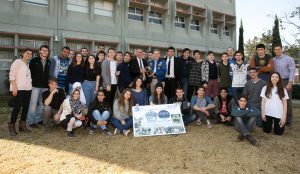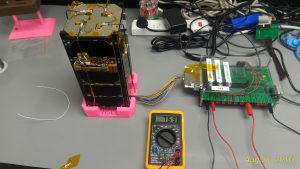×


We have detected your country as:
Please click here to go to the USA website or select another country from the dropdown list.
by: Ilse Posselt

The Israeli students behind the Duchifat-2 nanosatellite (Photo Credit: Ofer Amram / www.h-space-lab.org)
Thursday, 20 April 2017 | The National Aeronautics and Space Administration launched a nanosatellite built by Israeli high school students into space to help map the earth’s atmosphere.
Named Duchifat-2 (Hoopoe) after Israel’s national bird, the Jewish state’s tiny satellite forms part of a fleet of 28 nanosatellites from 23 countries around the world participating in the European Union’s QB50 thermosphere international research program. Israel’s offering is, however, the only satellite built entirely by teenagers in high school. The remaining satellites are the handiwork of either college students or researchers.
For the past two years, more than 80 students from high schools in Herzliya, Ofakim, Yeruham, Ofra and the Bedouin town of Hura worked together on a joint initiative of the Israel Space Agency and the Herzliya Science Center to build the Duchifat-2. Academic engineers and experts from the Israel Aerospace Industries were close at hand throughout the entire process to share knowledge and offer guidance.
Fourteen pupils from Herzliya and Hura had the opportunity to travel to Cape Canaveral to watch their handiwork being launched into space.
The bevy of tiny satellites together with more than three tons of supplies blasted off aboard an Atlas V supply rocket from the Kennedy Space Center in Cape Canaveral, Florida and is now heading for the International Space Station. The cargo is expected to reach its destination two days after liftoff.
In six weeks’ time, astronauts in the Japanese section of the space station will release the satellites into the atmosphere using a special robotic arm. According to The Times of Israel, the Duchifat-2 will be responsible for studying the plasma density in the lower thermosphere. The satellite will send signals directly to the Herzliya Science Center, where students involved in the project will be at hand to analyze the data received.

Hoopoe – Duchifat 2 (Photo Credit: www.h-space-lab.org)
Duchifat-2 weighs in at a mere 1.8 kg (3.96 lbs) and at 20 cm (7.87 in) tall by 10 cm (3.93 in) wide; the satellite is approximately the size of a standard milk carton. Given its tiny statute, it has no motors and relies on the earth’s magnetic field to maintain correct alignment in the atmosphere.
Duchifat-2’s predecessor, Duchifat-1, was also developed in collaboration with the Herzliya Science Center. The Duchifat-1 was sent to space in June 2014 and is still active nearly three years later.
Commenting on the launch, Israel’s Science Minister, Ofir Akunis, said in a statement, “Duchifat-2 is not only an educational venture that brings space closer to youth and lays the way for tomorrow’s generation, it is also an international research project. This is Israeli pride for the future generation, and an opportunity to increase public awareness about space.”
Posted on April 20, 2017
Source: (Bridges for Peace, 20 April 2017)
All logos and trademarks in this site are property of their respective owner. All other materials are property of Zealous 8:2. Copyright © 2025.
Website Site Design by J-Town Internet Services Ltd. - Based in Jerusalem and Serving the World.